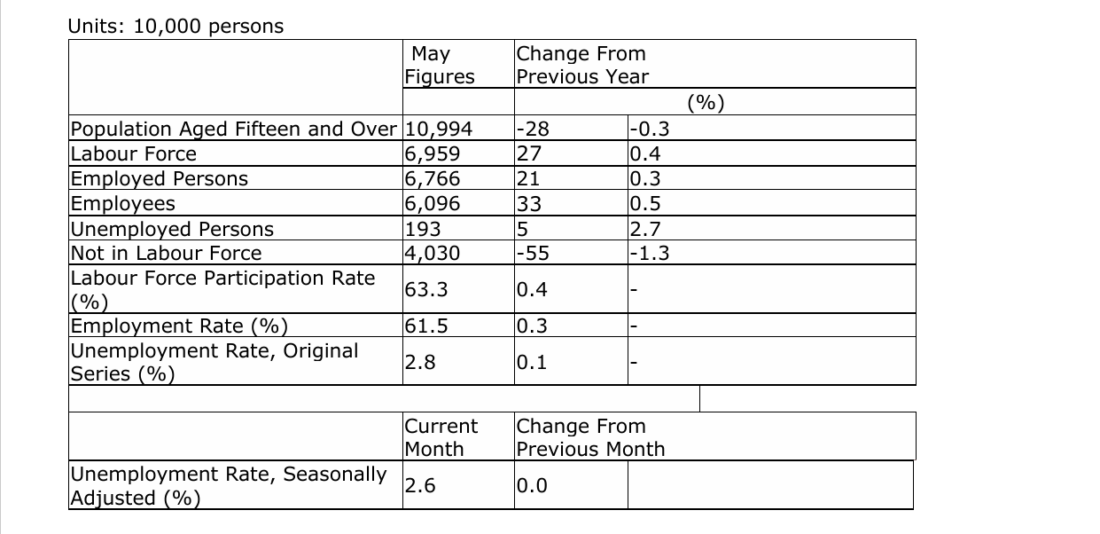Economic and Labour Situation in Japan, July 2024
Final tally of wage hike settlements in the 2024 Spring Struggle for a Better Life: in excess of 5% for the first time in 33 years
On July 3, RENGO (Japanese Trade Union Confederation) carried out its final tally of wage hike settlements reached in the 2024 Spring Struggle for a Better Life. RENGO’s tally revealed that 5,284 unions that had demanded average wage hikes for members and engaged in labour–management negotiations had reached settlements by that time.
The average wage hike in these settlements (including the regular wage hike) was 15,281 yen, the equivalent of 5.1% of the average wage before the hike: more than at the same stage last year at 4,721 yen and 1.52 percentage points.
At unions with more than 1000 members, the average wage hike was 16,362 yen, up 5.24%: more than at the same stage last year at 4,982 yen and 1.55 percentage points.
Of unions with fewer than 300 members, the average wage hike was 11,358 yen, up 4.45%: more than at the same stage last year at 3,337 yen and 1.22 percentage points, and reaching the highest level since 1992 compared to final tallies of the past.
At a press conference, Akira Nihira, Director of the Policy Promotion Bureau at RENGO, looked back and commented, “Efforts to pass on costs were insufficient in small- and medium-sized enterprises.” It appears that securing the necessary funds for wage increases proved difficult.
Labour Force Survey Monthly Results*1
(1) Employment
The number of employed persons in May 2024 was 67.66 million, an increase of 210,000 over the same month the previous year. By gender, this included 36.93 million men, down 40,000, and 30.72 million women, up 250,000 over the previous year.
(2) Unemployment
The number of unemployed persons in May 2024 was 1.93 million, an increase of 50,000 from the same month in the previous year.
The seasonally adjusted unemployment rate in May was 2.6%, unchanged from the previous month. The unemployment rate for men was 2.9%, up 0.1 points over previous month, and for women 2.3%, down 0.1 points from the previous month.

(3) Job Availability
Japan’s job availability in May stood at 1.24, down 0.02 points from the previous month. This ratio means there were 124 job openings for every 100 job seekers.
The ratio of regular employee job offers to applicants was 1.00, down 0.02 points from the previous month.
The ratio of new job offers to applicants, a leading indicator for the labour market, was 2.16, down 0.01 points from the previous month. The number of new job offers decreased 0.6%. By industry, information and communications rose 5.7%. Living-related and personal services and amusement services fell 10.6%, while the manufacturing dropped 7.4%.
Industrial Production*2
Industrial output in May increased 2.8% over the previous month, as Daihatsu Motor Co. fully resumed production following a safety test scandal. Production, shipment, and inventories all increased, while inventory ratio decreased. The industries that mainly contributed to this increase were as follows: (1) motor vehicles; (2) electrical machinery, and information and communication electronics equipment; and (3) general-purpose and business oriented machinery, in that order.
According to the Survey of Production Forecasts in Manufacturing, production was expected to decrease 4.8% in June and increase 3.6% in July. The expected drop in June reflects partial production halts at Toyota Motor Corp. and Mazda Motor Corp. following a recent vehicle certification scandal also involving Honda Motor Co., Suzuki Motor Corp., and Yamaha Motor Co.

Family Income and Expenditure Survey*3
(1) Expenditure of Households of Two Persons or More
Average monthly consumption expenditure of households of two or more persons in May was 290,328 yen, up 1.4% in nominal terms but down 1.8% in real terms over the previous year, the first decline in two months, as rising prices prompted people to cut back on food expenditure and a weak yen discouraged travel abroad.
(2) Income and Expenditures for Workers’ Households
Average monthly income per household stood at 500,231 yen, up 6.4% in nominal terms and up 3.0% in real terms from the previous year, marking the first increase in 20 months. The average level of consumption expenditure was 318,560 yen per month, up 2.2% in nominal terms but down 1.1% in real terms year-on-year.
Consumer Prices*4
The consumer price index (CPI) in May was 108.1 (2020 = 100), up 2.8% over the previous year and up 0.5% over the previous month. Core inflation (CPI less food and energy) was up 2.1% over the previous year and up 0.1% over the previous month, reflecting higher energy costs and elevated food prices. Energy prices increased 7.2%, with electricity jumping 14.7%. Food prices (excluding volatile fresh items) rose 3.2%.

<Y.A>
1. Source: Labour Force Survey Monthly Results (Statistics Bureau of Japan)
https://www.stat.go.jp/english/data/roudou/results/month/index.html
2. Source: Indices of Industrial Production (Ministry of Economy, Trade and Industry)
https://www.meti.go.jp/english/statistics/tyo/iip/index.html
3. Source: Summary of the Latest Month on Family Income and Expenditure Survey (Statistics Bureau of Japan)
https://www.stat.go.jp/english/data/kakei/156.html
4. Source: Consumer Price Index (Statistics Bureau of Japan)
https://www.stat.go.jp/english/data/cpi/1581-z.html
